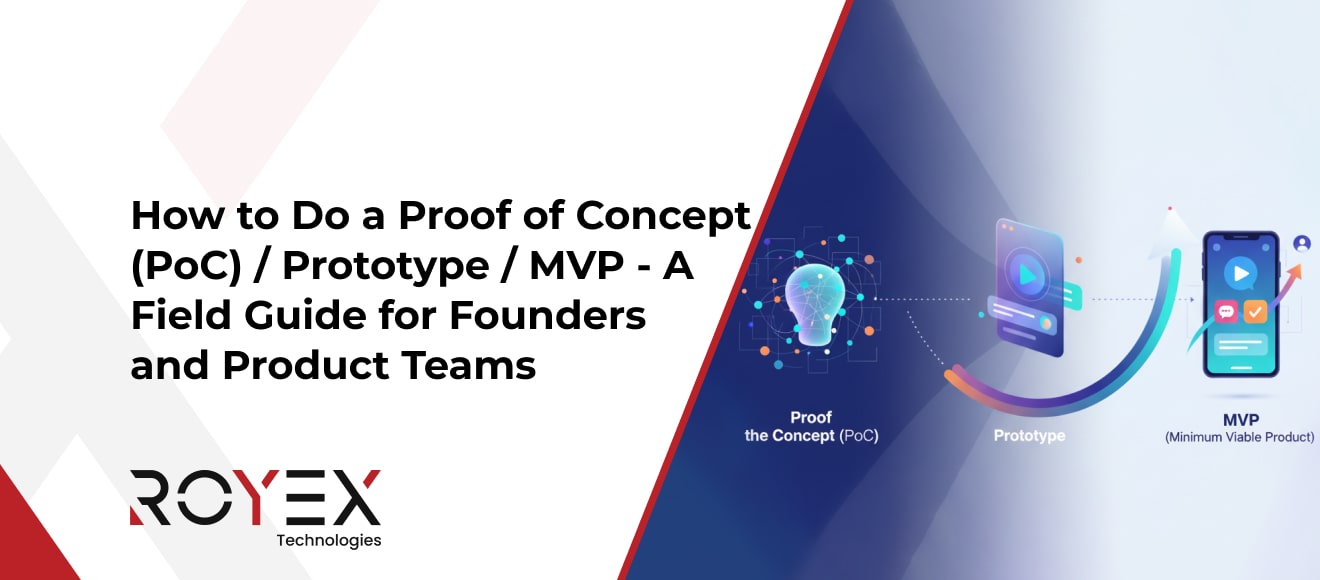
How to Do a Proof of Concept (PoC) / Prototype / MVP — A Field Guide for Founders and Product Teams
Series note: Based on common questions asked by our customers before developing mobile apps, we have listed most of the questions and answers in detail for each topic. This article is part of our series “Mobile App Journey: Things You Must Know.”
Bringing a new mobile app to life is a high-uncertainty journey. Great ideas can stumble on technical feasibility, team bandwidth, market indifference, or the brutal math of time and budget. The smartest founders de-risk early, treating product development as a sequence of evidence-gathering experiments rather than a single, high-stakes launch.
That’s where Proofs of Concept (PoCs), Prototypes, and Minimum Viable Products (MVPs) come in.
What You’ll Learn in This Guide
-
What PoC, prototype, and MVP really mean—and how they differ
-
When to use each, with mobile-specific examples
-
Step-by-step playbooks to build them well
-
How to pick the right level of fidelity and scope
-
Metrics to track and the gates to pass before moving forward
-
Pros & cons of each approach
-
Fresh statistics that show why disciplined experimentation matters
-
Why a seasoned partner like Royex can materially improve your odds of success
Why Stages Matter (and Save You Money)
-
Large IT projects, on average, run 45% over budget and 7% over time, while delivering 56% less value than predicted (McKinsey & Company).
-
Around 64% of shipped features are rarely or never used, showing the importance of validating before you build (Standish Group via Mountain Goat Software).
-
“No market need” remains the most common reason startups fail (CB Insights).
👉 PoC → Prototype → MVP creates a ladder of evidence so you can invest progressively as confidence increases.
Definitions at a Glance
-
Proof of Concept (PoC):
A feasibility experiment to show that a risky assumption—technical, regulatory, or data-related—can work in principle. Not for users; it’s for risk retirement. -
Prototype:
A representation of the product (sketches, clickable flows, or coded sandboxes) used to test usability, interaction, and value perception with real people. -
Minimum Viable Product (MVP):
A functional, shippable product with only the must-have features necessary to test core hypotheses with early adopters. Its purpose is validated learning.
A helpful way to remember it:
-
PoC asks “Can it be done?”
-
Prototype asks “Do users get it?”
-
MVP asks “Will anyone use/pay for it—again?”
When to Use Which (Mobile-Specific Decision Guide)
| Dominant Risk | Use | Mobile Example | What You Learn |
|---|---|---|---|
| Deep technical unknowns (ML, sensor fusion, streaming, encryption) | PoC | Test TensorFlow Lite inference speed, offline map rendering, WebRTC stability | Feasibility & performance |
| User experience & desirability | Prototype | Clickable Figma for habit-tracker, tappable flows for ordering app, hi-fi telemedicine consult flow | Usability & value perception |
| Business model & retention | MVP | Slimmed-down music practice app, curated deals app in one city, B2B pilot |
Engagement, retention, conversion |
Playbooks
1. Building a Rock-Solid PoC
-
Purpose: Retire technical/compliance risks early.
-
Scope: 2–6 weeks, focus on top 3 unknowns.
-
Pros: Cheap, fast risk retirement, credibility with stakeholders.
-
Cons: No UX learning, throwaway code.
2. Crafting a Prototype Users Understand
-
Purpose: Validate usability and value perception.
-
Fidelity ladder: Low-fi sketches → mid-fi wireframes → hi-fi clickable mockups.
-
Pros: Tremendous learning per dollar, rapid iteration.
-
Cons: Not production-ready, needs structured testing.
3. Shipping an MVP That Learns
-
Purpose: Measure real-world behavior—retention, conversion, willingness to pay.
-
Checklist:
-
Must-have journeys only
-
Secure auth & analytics from day one
-
In-app feedback loop
-
Small but complete slice
-
-
Pros: Validates with real behavior, attracts early adopters.
-
Cons: Requires operational overhead, risks reputation if rushed.
Picking the Right Fidelity (and Cost)
-
PoC cost: 1× (days)
-
Prototype cost: 2–5× (weeks)
-
MVP cost: 10–20× (1–3 sprints+)
👉 Invest progressively to avoid big-bang failures.
What to Validate at Each Stage
-
PoC: Technical feasibility → benchmarks prove no show-stoppers.
-
Prototype: Usability & comprehension → task success >80%.
-
MVP: Retention & conversion → improving cohort metrics.
Common Patterns by App Category
-
Consumer utilities: Focus on performance, battery, paywall test.
-
Social/creator apps: Media handling, sharing clarity, early engagement loops.
-
Health & wellness: Secure storage, sensitivity of tone, adherence/retention.
-
Fintech/commerce: Payment SDKs, checkout friction, compliance.
-
B2B field/operations: Offline sync, minimal input, departmental pilots.
Why Royex is an Excellent Partner for PoC → Prototype → MVP
-
Track record across domains: E-commerce, health, logistics, AI-driven apps.
-
Experiment-first mindset: Hypothesis-driven builds, not guesswork.
-
Design that learns: Prototypes tested before hitting the App Store.
-
MVPs that ship: Store-compliant, analytics-enabled, growth-ready.
-
Post-launch support: Crash triage, performance tuning, compliance hardening.
👉 Royex Technologies blends technical judgment, design, and growth pragmatism to move you from idea → evidence → impact.
FAQs (Quick Hits)
-
Can I skip PoC? Yes, if risks are user-experience based. But do PoC if technical unknowns exist.
-
How polished should MVP be? Small but complete—must pass store guidelines.
-
How many users for prototype testing? 5–8 per round is enough to spot key issues.
-
What’s the #1 thing to measure in MVP? Retention. If users don’t return, nothing else matters.
Closing Perspective
As Eric Ries said: the MVP exists to maximize learning, not just minimize scope. Treat PoC → Prototype → MVP as your evidence escalator. Ride it with discipline and you’ll save money, avoid wasted features, and grow with data-driven confidence.
Partnering with Royex improves your odds even further, thanks to experience, discipline, and proven delivery.
We are a leading mobile app development company in Dubai, that provides innovative solutions for small, medium, and large-scale companies. We specialize in responsive web development, mobile app development, CRM integration, AI solutions for website & mobile applications, and many more. Our extensive experience in mobile app development will help you to take your business to a high level.
Check our portfolio to see our previous works. Contact us via email at info@royex.net or call us at +971566027916. To get started with us.





